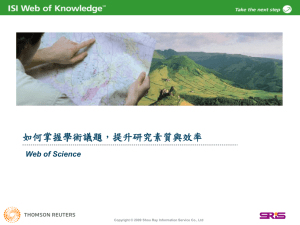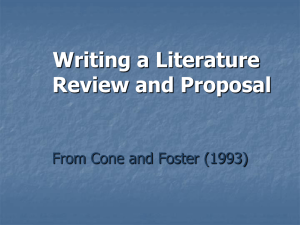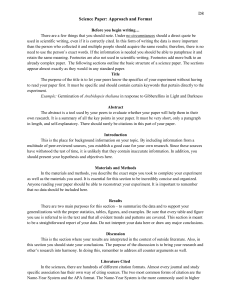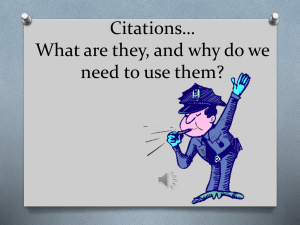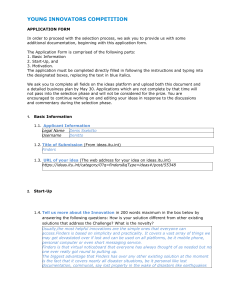Common Citations
advertisement
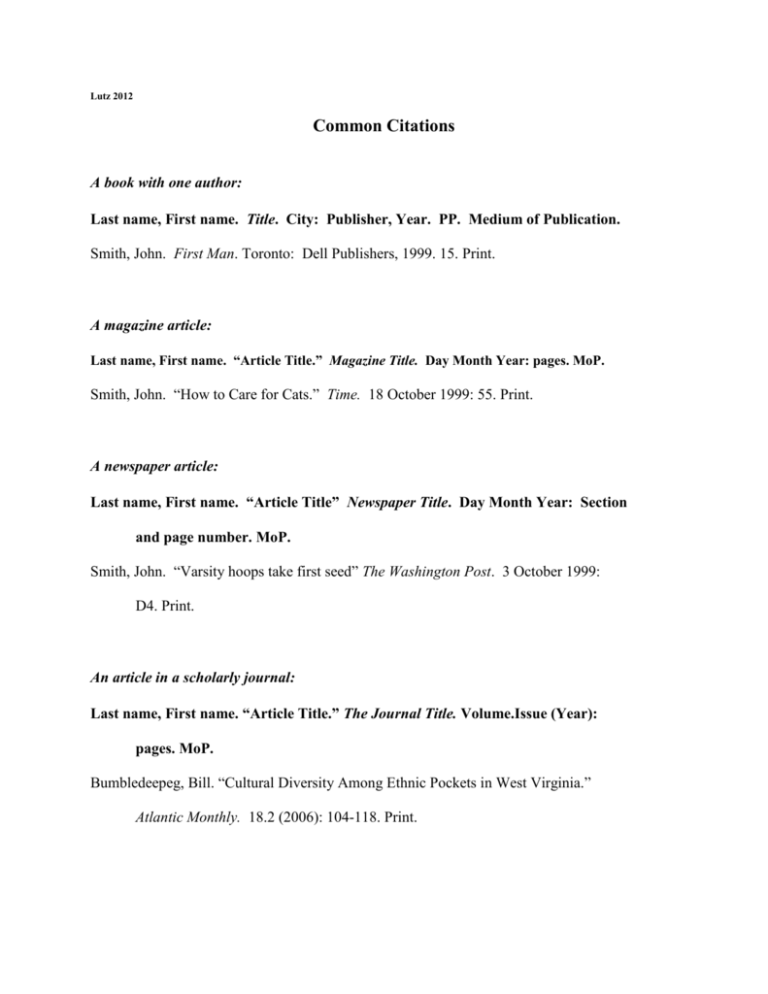
Lutz 2012 Common Citations A book with one author: Last name, First name. Title. City: Publisher, Year. PP. Medium of Publication. Smith, John. First Man. Toronto: Dell Publishers, 1999. 15. Print. A magazine article: Last name, First name. “Article Title.” Magazine Title. Day Month Year: pages. MoP. Smith, John. “How to Care for Cats.” Time. 18 October 1999: 55. Print. A newspaper article: Last name, First name. “Article Title” Newspaper Title. Day Month Year: Section and page number. MoP. Smith, John. “Varsity hoops take first seed” The Washington Post. 3 October 1999: D4. Print. An article in a scholarly journal: Last name, First name. “Article Title.” The Journal Title. Volume.Issue (Year): pages. MoP. Bumbledeepeg, Bill. “Cultural Diversity Among Ethnic Pockets in West Virginia.” Atlantic Monthly. 18.2 (2006): 104-118. Print. An Introduction, Preface, Fore word, or After word: Last name, First name. Category of placement. “Title.” Book title. By author. Year of the piece. Edition of the piece. City: Publisher, year. Pages (maintain Roman numbering as needed). MoP. Callan, Edward. Introduction. Cry, the Beloved Country. By Alan Paton. New York: Macmillan, 1987. xvi-ixx. Print. A single author or work in an anthology: Last name, First name. “Short story title.” Anthology title. Edition. Editor’s first name & last name. City: Publisher, year. Page range. MoP. McGillicutty, Bubbles. “Can’t Wait To Dance.” Modern American Short Fiction. 3rd ed. Ed. Bill Smith. Tucson: Dover Limited, 2006. 403-415. Print. An interview (either personal or telephone): Last name, First name. Type of interview. Day Month (abbrev.) year. O’Donnell, Bubbles. Telephone interview. 5 Jan. 2005. Internet sources with author and title (URLs are NOT included in the citation): Last name, First name. “Article title.” Title of the Website, project or book. Version number (i.e., version, revision, posting date, volume, issue, etc.). Name of institution/organization affiliated with the site (sponsor or publisher; use n.p. to note absence of information). MoP. Date of access. McKeown, Peaches. “Finding a job.” Unemployedactors.com. 27 Feb. 2003. National Job Finders. Web. 7 April 2004. Internet source with no author (same as above except with no author; URLs are NOT included in the citation): “Finding a job.” Unemployedactors.com. 27 Feb. 2003. National Job Finders. Web. 7 April 2004. Internet source with no title (URLs are NOT included in the citation): McKeown, Peaches. Unemployedactors.com. 27 Feb. 2003. National Job Finders. Web. 7 April 2004. Internet source with no author and no title (URLs are NOT included in the citation): Unemployedactors.com. 27 Feb. 2003. National Job Finders. Web. 7 April 2004. Class handout: Author’s last name, First name. “Work’s title.” Class handout. Teacher’s name. Date of receipt. Pages cited. MoP. Eliot, T.S. “The Hollow Men.” Class handout. Michael Lutz. 6 October 2005. 3-4. Print. Film or Video: Title. Director’s first and last names. Distributor’s name, Year of release. MoP. It’s a Wonderful Life. Dir. Frank Capra. RKO, 1946. Film. Work of Art: Artist’s last name, first name. Title. Date of composition. Medium of composition. Institution that houses the work (or name of collection – i.e. Collection of… If unknown note Private Collection.), City where it is housed. Bearden, Romare. The Train. 1974. Photogravure and aquatint. Museum of Modern Art, New York. Misc. Information Regarding Citations A Works Cited page is a resource list that comes on a separate page at the end of your paper and credits any author from whom you took information for use in your essay. It is on its own page and is labeled as such, with all entries in alphabetical order. A Works Consulted page is contains ANY research you conducted in working on the essay, regardless of whether or not it is cited in the body of your paper. It follows the same format as a Works Cited page. Its purpose is to document the extent of research you conducted and thereby to validate your opinion. Format notes: WC page title is centered and capitalized appropriately in the standard font of your paper (12). Entries are alphabetized according to the first unit of data - i.e., usually the author’s last name but in the case of the same last name, the titles would determine the order Any significant element missing in the citation should be noted in brackets if there is a concern of its omission; e.g., no date – [n.d.], no author – [n.a.] Double space everything. Indent all lines beyond the first line of an entry, which is flush with the left margin. This creates a “hanging indent.” Each entry must designate the Medium of Publication (i.e., Print, Film, Web, CD-ROM, DVD, etc.) Excepting the first word, do not capitalize articles (a, an, the), prepositions, or conjunctions in titles. Longer works are italicized (not underlined). Shorter works are quoted. Internal citation (i.e. parenthetical citation): In the body of your essay, you cite the source’s first unit of data from the Works Cited (i.e., usually the author’s last name) and the page number on which it occurred. Do NOT include commas, “pp.” or “pg.” or the word “page” for prose sources. Poetry sources should include the author’s last name and the word “line” (or “lines”). Their abbreviated forms are “l.” and “ll.” respectively. Place the citation in parentheses outside of the quote (since everything inside quotation marks is part of the quotation). However, it is part of your sentence and should never occur after the period. Place the parenthetical citation after the quote just before the first grammatical pause (i.e., a comma, semi-colon, or end-punctuation). E.g., John wants to “find the night in his heart” because he feels that no one knows the truth about him (Smith 41). [Here there is no grammatical pause until the end of the sentence, so the citation occurs there.] John wants to “find the night in his heart” (Smith 41); he feels that no one knows the truth about him. [Here there is a grammatical pause – the semi-colon, so the citation occurs just before it.] Tonya Jensin Mr. Lutz English 10 / Period 4 Notice the “hanging indents” and the alphabetical order of the entries. This is called a “heading.” It only occurs on the first page of your document. Notice the format for the date. This is a “header” and includes the student’s last name and the page number. Note that the Works Cited counts as a separate, final page. Headers occur on every page. Jensin 1 23 Sept. 2012 Works Cited Bumbledeepeg, Bill. “Cultural Diversity Among Ethnic Pockets in West Virginia.” Atlantic Monthly. 18.2 (2006): 104-118. Print. Callan, Edward. Introduction. Cry, the Beloved Country. By Alan Paton. New York: Macmillan, 1987. xvi-ixx. Print. McGillicutty, Bubbles. “Can’t Wait To Dance.” Modern American Short Fiction. 3rd ed. Ed. Bill Smith. Tucson: Dover Limited, 2006. 403-415. Print. McKeown, Peaches. “Finding a job.” Unemployedactors.com. 27 Feb. 2003. National Job Finders. Web. 7 April 2004. Smith, John. First Man. Toronto: Dell Publishers, 1999. 15. Print. Smith, John. “Varsity hoops take first seed” The Washington Post. 3 October 1999: D4. Print. Notice that everything is doublespaced. Tonya Jensin Jensin 1 Mr. Lutz English 10 / Period 4 23 Sept. 2012 Works Cited Bumbledeepeg, Bill. “Cultural Diversity Among Ethnic Pockets in West Virginia.” Atlantic Monthly. 18.2 (2006): 104-118. Print. Callan, Edward. Introduction. Cry, the Beloved Country. By Alan Paton. New York: Macmillan, 1987. xvi-ixx. Print. McGillicutty, Bubbles. “Can’t Wait To Dance.” Modern American Short Fiction. 3rd ed. Ed. Bill Smith. Tucson: Dover Limited, 2006. 403-415. Print. McKeown, Peaches. “Finding a job.” Unemployedactors.com. 27 Feb. 2003. National Job Finders. Web. 7 April 2004. Smith, Alex. First Man. Toronto: Dell Publishers, 1999. 15. Print. Smith, John. “How to Care for Cats.” Time. 18 October 1999: 55. Print.
